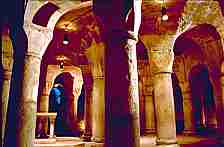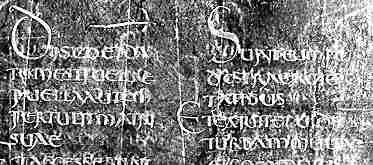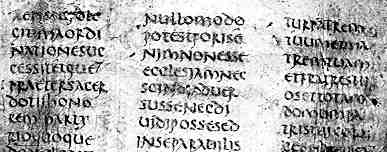
The Merovingian crypt of the Benedictine monastery of Dijon, France.




If you are looking at this page without frames, there is more information about medieval writing to be found by going to the home page (framed) or the site map (no frames).
| Modes of Reading in the Middle Ages | ||||
| If we start with the early missionising period after the waning of the Roman Empire, we have only a few rare examples of the books which we know must have been copied and recopied in order for them to have remained in the literate tradition at all. We do know that from the Lombards in northern Italy to the Franks, Saxons and Scandinavians in the north of Europe, the majority of the populace was illiterate. The literate tradition survived in the monastic communities, thinly scattered across the landscape and probably connected more among themselves than to the peoples of the places where they lived. | ||||
| A major function of Benedictine monasticism from the beginning, as laid down in the Rule of St Benedict, was the performance of the liturgy. This entailed the learning and oral proclamation of a lengthy series of learned texts in Latin, ratified by church authority. It included the recitation of the entire psalter, along with all the associated texts, in a defined sequence over the course of a week, with special texts for particular feast days. |  |
|||
The Merovingian crypt of the Benedictine monastery of Dijon, France. |
||||
| In order to preserve the integrity of these orally proclaimed Biblical texts, they were preserved and copied in writing, but it is most unlikely that many of the actual performers learned them by studying written words at that time. The rendering of the performance in the musical form known to us as plainchant or Gregorian chant was most likely taught entirely as an oral process. People remembered a lot. Early liturgical texts tend to represent the particular segments of the mass or divine office that were carried out by particular major performers. The complete liturgical books, containing both words and music, the breviary and the missal, appeared rather later. It is a facet of preservation rather than use that early liturgical books tend to be fancy, prestige volumes that have been curated for centuries as valuable items of property. The working crib notes for the priest, the deacon or the choirmaster have mainly disappeared through use, changes in liturgical fashion and continuing regularisation of the text with newly ratified copies. A continuing tradition of oral rendering of tightly prescribed texts did not require every performer to have a high level of reading literacy in Latin. | ||||
 |
This is a sample from the writings of St Hilarius of Poitiers, dating from 509-10 AD (Rome, Archivio di S. Pietro, D.182. (From Steffens 1929) | |||
| The earliest texts for study were in continuous writing, whether in the form of majuscule scripts like square capitals, rustic capitals or uncial, or in half uncial as in the above example. There was virtually no punctuation or separation between words, and each line was crammed full of letters from left to right, proceeding to the next line with no consideration given to how this fitted with the reading. The process of reading would have been slow, and would have involved tracking along the lines of text with the eyes, possibly with the aid of a finger or some sort of ruler. Possibly the reader spoke the words aloud, or at least mouthed them, in order to untangle the continuous sequence of graphic signs into words. There are no graphic markers for significant places in the text. Probably only the most literate and scholarly of readers would have made much sense of a dense and complex text like that of St Hilarius of Poitiers while reading in this manner. | ||||
 |
Segment from the Codex Palatinus, 4-5th Century (British Library, add. ms. 40107, f.1r), by permission of the British Library. | |||
| Even the core text of Christianity was not written in a way that was easy to read. This early version of the Gospel of St Matthew, wriiten in silver uncials on purple vellum, is divided into columns and has some enlarged capitals as locating aids, but the text within the columns just runs on continuously. There was just one advantage at this time, and that was that Latin was the vernacular of these people, and was also a phonetic language with consistent spelling and grammatically defined word endings. | ||||
 |
Segment from fragments of the Epistles of St Cyprian, 4-5th century (British Library, add. ms. 40165a), by permission of the British Library. | |||
| Nonetheless, battling along through a theological treatise like that above in three column uncial script would have been hard going for the most scholarly of readers. It is perhaps not surprising that many of the surviving texts of this type are found in fragmentary, discarded form. The one above does duty as flyleaves for a later codex. Some have been found as the bases for palimpsests. | ||||
 |
Square capitals used in a manuscript of Virgil's Aeneid from the Library of St Gall (Cod.1394,p.12). (From Steffens 1929) | |||
| This laborious writing is the same as that used for prestige volumes of the works of pagan Classical writers, notably Virgil, in the late antique period. The above uses the exceedingly formal square capitals in continuous writing. These works were collected and preserved in monastic institutions as examples of the finest form of the Latin language, and possibly developed an increasing significance as Latin changed from the vernacular to a second language for many of those who mouthed it in formal contexts within the church. | ||||
| In this form of reading, the primary conceptual unit is the letter. Words are mentally constructed from sequences of letters, and sentences created in the reader's mind from sequences of words. It is what modern educators call phonics, but because it is being used in a phonetic language, it actually works. The text is constructed entirely as a linear sequence of individual graphic signs which pass before the eyes of the reader, a little like those electronic advertising signs that scroll text across a space. | ||||
|
|
||||
|
If you are looking at this page without frames, there is more information about medieval writing to be found by going to the home page (framed) or the site map (no frames). |
||||